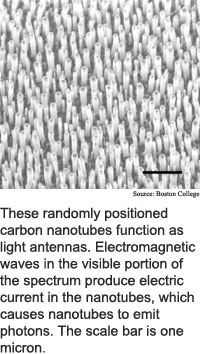
Nanotubes tune in light
By
Eric Smalley,
Technology Research NewsAn antenna transmits and receives electromagnetic waves at wavelengths that are close to the length of the antenna, and it does so by converting electrical current to electromagnetic waves and vice versa. The electromagnetic spectrum spans radio waves, microwaves, heat waves, visible lightwaves, ultraviolet waves, x-rays, and gamma rays.
Carbon nanotubes, which are rolled-up sheets of carbon atoms that can be smaller than a nanometer in diameter, can act as antennas, but instead of transmitting and receiving radio waves, which are at the longest end of the electromagnetic spectrum, antennas of their size pick up the nanoscale wavelengths of visible light. A nanometer is one millionth of a millimeter. In contrast, radio wave wavelengths are measured in meters.
Researchers at Boston College, the U.S. Army Natick Soldier Center, Mega Wave Corporation and Florida International University have demonstrated the light antenna effect using multiwalled carbon nanotubes. "Aligned carbon nanotubes receive and transmit light just like radio frequency antennas receive and transmit radio waves," said Zhifeng Ren, a physics professor at Boston College.
The method could be used to convert optical signals to electrical signals in communications equipment, to carry out optical computing, to detect different wavelengths of light including the infrared wavelengths used in telecommunications equipment, and to convert sunlight to electricity in solar energy applications, said Ren.
Antennas convert electromagnetic waves into electric current when electromagnetic waves that have a wavelength equal to or a small multiple of an antenna's length cause electrons in the metal to move. Antennas also do the reverse: an electric current in an antenna generates electromagnetic waves that have a wavelength equal to the length of the antenna.
To make the light antennas, the researchers grew arrays of multiwalled carbon nanotubes that were 50 nanometers in diameter and varied in length from 200 to 1,000 nanometers. Visible lightwaves range from 400 to 700 nanometers long from crest to crest, which is about ten times smaller than a red blood cell.
Because the frequency of visible lightwaves is so fast, oscillations in the electric current produced by visible light antennas are too quick to be measured using today's electronics. The researchers measured the behavior of the carbon nanotube arrays by instead recording the lightwaves that the minuscule antennas reradiated.
The researchers demonstrated two signature effects of antennas -- polarization and length matching. They showed that a nanotube antenna's response to an electromagnetic wave diminishes as the wave's electric field is rotated perpendicular to the nanotube -- the polarization effect. And they demonstrated that a nanotube antenna's response is strongest when its length is a multiple of half the wavelength of the electromagnetic wave -- the length-matching effect.
The researchers also showed that nanotube antennas are high quality, with electrons in the nanotubes scattering at a low rate comparable to conducting metals like copper.
Devices that incorporate nanotube antennas could be tuned to very specific light frequencies using nanotubes grown to specific lengths.
One key to realizing practical applications of nanotube antennas is coming up with fast nanoscale diodes capable of capturing the high-speed electrical signals the antennas produce. A diode allows electrical current to flow in only one direction.
Practical nanotube antennas could be developed in two to five years, according to Ren.
Zhifeng's research colleagues were a Yang Wang, Krzysztof Kempa, Thomas Kempa, Jakub Rybczynski and Andrzej Herczynski of Boston College, Brian Kimball and Joel Carlson of the U.S. Army Natick Soldier Center, Glynda Benham of Mega Wave Corporation, and Wenzhi Li of Florida International University. The work appeared in the September 27, 2004 issue of Applied Physics Letters. The research was funded by the U.S. Army and the National Science Foundation (NSF).
Timeline: 2-5 years
Funding: Government
TRN Categories: Optical Computing, Optoelectronics and Photonics; Nanotechnology
Story Type: News
Related Elements: Technical paper, "Receiving and Transmitting Light-like Radio Waves: Antenna Effect in Arrays of Alignment Carbon Nanotubes," Applied Physics Letters, September 27, 2004
Advertisements:
November 17/24, 2004
Page One
Fibers mix light and electricity
Software sorts out subjectivity
Nanomechanical memory demoed
Nanotubes tune in light
Briefs:
Low-pressure material holds hydrogen
Plastic cuts artificial hip wear
2D holograms make 3D color display
Lasers drive nano locomotive
Light-recording plastic holds up
Atom flip energy measured

News:
Research News Roundup
Research Watch blog
Features:
View from the High Ground Q&A
How It Works
RSS Feeds:
News
Ad links:
Buy an ad link
| Advertisements:
|
 |
Ad links: Clear History
Buy an ad link
|
TRN
Newswire and Headline Feeds for Web sites
|
© Copyright Technology Research News, LLC 2000-2006. All rights reserved.